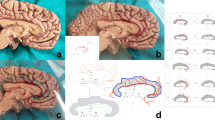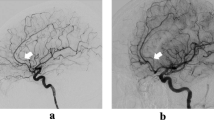Abstract
Background and purpose
The subcallosal artery [SCA, a branch of the anterior communicating artery (ACoA)] is not well described in the literature. However, the memory disorders that can occur after surgical repair of ruptured ACoA aneurysms might be related to infarction of the SCA. The objective of the present study was to perform a thorough anatomical assessment of the SCA.
Methods
The study was carried out over a 6-month period in a University Hospital’s anatomy laboratory, using brains extracted from human cadavers. The brains were injected with colored neoprene latex and dissected to study the SCA’s origin, path, termination, diameter, length, and vascularized territories.
Results
21 cadaveric specimens were studied. The mean ± standard deviation diameter and length of the SCA were 0.83 ± 0.57 mm and 38.14 ± 25.11 mm, respectively. The predominantly vascularized territories were the paraterminal gyrus (100%), the parolfactory gyrus (78.95%), the rostrum (84.21%) and genu (78.95%) of the corpus callosum, the lamina terminalis (78.95%), the anterior commissure (63.16%), the anterior cingulate gyrus (47.37%), and the fornix (26.32%). When the SCA supplied the fornix and the anterior cingulate gyrus, it was significantly longer and broader (p < 0.05).
Conclusion
Anatomic knowledge of the SCA is crucial—especially for the treatment of ACoA aneurysms.








Similar content being viewed by others

References
Böttger S, Prosiegel M, Steiger HJ, Yassouridis A (1998) Neurobehavioural disturbances, rehabilitation outcome, and lesion site in patients after rupture and repair of anterior communicating artery aneurysm. J Neurol Neurosurg Psychiatry 65:93–102
DeLuca J, Diamond BJ (1995) Aneurysm of the anterior communicating artery: a review of neuroanatomical and neuropsychological sequelae. J Clin Exp Neuropsychol 17:100–121. https://doi.org/10.1080/13803399508406586
Gade A (1982) Amnesia after operations on aneurysms of the anterior communicating artery. Surg Neurol 18:46–49
Jackowski Meneses, Ramina Marrone, Stefani Aquini, Winkelmann Schneider (1999) Perforating and leptomeningeal branches of the anterior communicating artery: an anatomical review. Crit Rev Neurosurg 9:287–294
Kakou M, Velut S, Destrieux C (1998) Arterial and venous vascularization of the corpus callosum. Neurochirurgie 44:31–37
Kannath SK, Malik V, Rajan JE (2017) Isolated subcallosal artery infarction secondary to localized cerebral vasospasm of anterior communicating artery complex following subarachnoid hemorrhage. World Neurosurg. https://doi.org/10.1016/j.wneu.2017.07.052
Lazorthes G, Gouazé A, Salamon G (1976) Vascularisation et circulation de l’encéphale. Anatomie descriptive et fonctionnelle, vol 1. Paris, Masson, pp 101–113
Marinković S, Gibo H, Milisavljević M (1996) The surgical anatomy of the relationships between the perforating and the leptomeningeal arteries. Neurosurgery 39:72–83
Marinković S, Milisavljević M, Marinković Z (1990) Branches of the anterior communicating artery. Microsurgical anatomy. Acta Neurochir (Wien) 106:78–85
Matsushige T, Chen B, Dammann P, Johst S, Quick HH, Ladd ME, Forsting M, Sure U, Wrede KH (2016) Microanatomy of the subcallosal artery: an in vivo 7 T magnetic resonance angiography study. Eur Radiol 26:2908–2914. https://doi.org/10.1007/s00330-015-4117-1
Meila D, Saliou G, Krings T (2015) Subcallosal artery stroke: infarction of the fornix and the genu of the corpus callosum. The importance of the anterior communicating artery complex. Case series and review of the literature. Neuroradiology 57:41–47. https://doi.org/10.1007/s00234-014-1438-8
Mortimer AM, Steinfort B, Faulder K, Erho T, Scherman DB, Rao PJ, Harrington T (2016) Rates of local procedural-related structural injury following clipping or coiling of anterior communicating artery aneurysms. J Neurointerv Surg 8:256–264. https://doi.org/10.1136/neurintsurg-2014-011620
Moussouttas M, Giacino J, Papamitsakis N (2005) Amnestic syndrome of the subcallosal artery: a novel infarct syndrome. Cerebrovasc Dis 19:410–414. https://doi.org/10.1159/000086104
Mugikura S, Kikuchi H, Fujii T, Murata T, Takase K, Mori E, Marinković S, Takahashi S (2014) MR imaging of subcallosal artery infarct causing amnesia after surgery for anterior communicating artery aneurysm. AJNR Am J Neuroradiol 35:2293–2301. https://doi.org/10.3174/ajnr.A4057
Onate Miranda M, Alba Suarez EM, Frutos R, Escribano Vera J, Palomo Ferrer F, Alvarez-Linera Prado J (2015) Amnestic syndrome of the subcallosal artery with additional penetrating vessel involvement. J Neurol Sci 359:438–439. https://doi.org/10.1016/j.jns.2015.10.014
Parmar H, Sitoh YY, Hui F (2005) Normal variants of the intracranial circulation demonstrated by MR angiography at 3T. Eur J Radiol 56:220–228. https://doi.org/10.1016/j.ejrad.2005.05.005
Serizawa T, Saeki N, Yamaura A (1997) Microsurgical anatomy and clinical significance of the anterior communicating artery and its perforating branches. Neurosurgery 40:1211–1216 (discussion 1216–1218)
Türe U, Yaşargil MG, Krisht AF (1996) The arteries of the corpus callosum: a microsurgical anatomic study. Neurosurgery 39:1075–1084 (discussion 1084–1085)
Turine G, Gille M, Druart C, Rommel D, Rutgers MP (2016) Bilateral anterior fornix infarction: the “amnestic syndrome of the subcallosal artery”. Acta Neurol Belg 116:371–373. https://doi.org/10.1007/s13760-015-0553-6
Author information
Authors and Affiliations
Contributions
Protocol/project development: LC, AK, PF, EH, JP. Data collection or management: LC, JP. Data analysis: LC, JP. Manuscript writing: LC.
Corresponding author
Ethics declarations
Conflict of interest
The authors report no conflict of interest concerning the materials or methods used in this study or the findings specified in this paper.
Additional information
Publisher's Note
Springer Nature remains neutral with regard to jurisdictional claims in published maps and institutional affiliations.
Rights and permissions
About this article
Cite this article
Chenin, L., Kaoudi, A., Foulon, P. et al. Microsurgical anatomy of the subcallosal artery. Surg Radiol Anat 41, 1037–1044 (2019). https://doi.org/10.1007/s00276-019-02279-8
Received:
Accepted:
Published:
Issue Date:
DOI: https://doi.org/10.1007/s00276-019-02279-8



